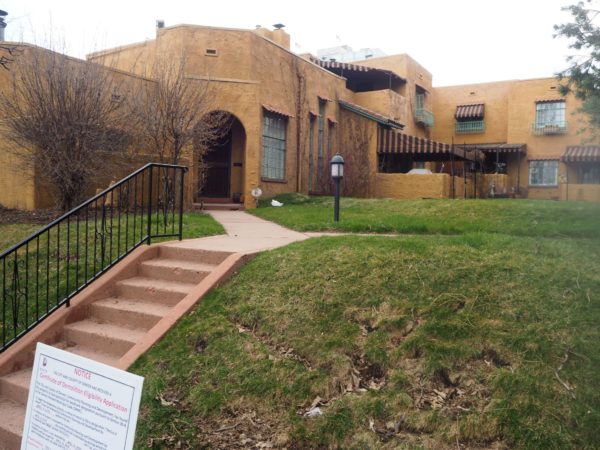An owner-opposed effort to designate a condo complex off Speer Boulevard a Denver city landmark has cleared its first hurdle.
The city’s Landmark Preservation Commission voted unanimously Tuesday afternoon to forward the landmark application for the six-unit Carmen Court complex at 900 E. 1st Ave. to City Council, which will make the final decision on the matter.
The owners of the six units are under contract to sell the building, and the lot it sits on, to Houston-based developer Hines. Last month, the owners told BusinessDen they want to sell in part because the building, which dates to 1925, is in need of hundreds of thousands of dollars’ worth of maintenance.

(Left to right) Karen Roehl, Mary Ann O’Hara and husband Gary Laura, Katie Sisk and Terrie Curry collectively own four of the units at Carmen Court. (BizDen file)
The landmark application was submitted by three Denver residents after the owners applied in March for a designation that would ensure Hines could demolish the structure. The company wants to build a five-story senior living complex on the site, which is already zoned for that height.
“We understand it is a difficult decision … but this is one of those iconic structures of Denver that should be preserved,” Malcolm Murray, one of the three applicants, said Tuesday.
Murray said his “Save Carmen Court” organization has about 140 members.
Owner-opposed landmark applications are rare in Denver. In the past year, ones have been submitted for Tom’s Diner, at 601 E. Colfax Ave., and the Olinger Moore Howard Chapel at 4345 W. 46th Ave. In both cases, before City Council could make a final decision, the owners of the properties found a different buyer who planned to preserve the structure.
In this case, however, the applicants, Hines and Carmen Court owners, already have gone through mediation, a recent addition to the city landmark process that is intended to find compromise sooner rather than later.
On Tuesday, those who submitted the landmark application for Carmen Court argued that the structure, which dates to 1925, met four criteria for landmark status. The commission disagreed on one point, the notion that the structure was a “significant example of the work of a recognized architect or master builder.”
The landmark applicants believe the structure was designed by Burt Rhoads, chief engineer of the Gates Rubber Co., a once-prominent local manufacturer. But the owners, who don’t want to see the property made a landmark, argued that it was unclear that Rhoads actually designed the building — documents from the time describe him as the building’s “originator” — and said his body of work is too small for him to be considered notable.
That argument swayed the commission. But the landmark application was still able to move forward because landmark applications need to meet only three criteria, and the commission decided the following three were met:
- – The structure “embodies the distinctive visible characteristics of an architectural style or type.”
– The structure “represents an established and familiar feature of the neighborhood … due to its prominent location or physical characteristics.”
– The structure “promotes understanding and appreciation of the urban environment by means of distinctive physical characteristics or rarity.”
The owners argued that the building wasn’t an example of a particular architectural style, but rather a combination of various styles. But the commission didn’t find that a problem.
“It’s a style you wouldn’t see on the East Coast, you wouldn’t see on the West Coast,” said Commissioner Anne Watternberg. “And that’s something very valuable to the community.”
About 20 members of the public spoke at the Tuesday landmark meeting. All but four were in favor of landmark status. Annie Levinsky, head of nonprofit Historic Denver, said the organization thinks the property “has great adaptive reuse potential.”
Katie Sisk, who owns one of the six Carmen Court units, said the Tuesday decision was “upsetting and frustrating,” but saw one upside moving forward.
“I would say it’s a small one that one of the criteria was thrown out, with the architect,” she said.
An owner-opposed effort to designate a condo complex off Speer Boulevard a Denver city landmark has cleared its first hurdle.
The city’s Landmark Preservation Commission voted unanimously Tuesday afternoon to forward the landmark application for the six-unit Carmen Court complex at 900 E. 1st Ave. to City Council, which will make the final decision on the matter.
The owners of the six units are under contract to sell the building, and the lot it sits on, to Houston-based developer Hines. Last month, the owners told BusinessDen they want to sell in part because the building, which dates to 1925, is in need of hundreds of thousands of dollars’ worth of maintenance.

(Left to right) Karen Roehl, Mary Ann O’Hara and husband Gary Laura, Katie Sisk and Terrie Curry collectively own four of the units at Carmen Court. (BizDen file)
The landmark application was submitted by three Denver residents after the owners applied in March for a designation that would ensure Hines could demolish the structure. The company wants to build a five-story senior living complex on the site, which is already zoned for that height.
“We understand it is a difficult decision … but this is one of those iconic structures of Denver that should be preserved,” Malcolm Murray, one of the three applicants, said Tuesday.
Murray said his “Save Carmen Court” organization has about 140 members.
Owner-opposed landmark applications are rare in Denver. In the past year, ones have been submitted for Tom’s Diner, at 601 E. Colfax Ave., and the Olinger Moore Howard Chapel at 4345 W. 46th Ave. In both cases, before City Council could make a final decision, the owners of the properties found a different buyer who planned to preserve the structure.
In this case, however, the applicants, Hines and Carmen Court owners, already have gone through mediation, a recent addition to the city landmark process that is intended to find compromise sooner rather than later.
On Tuesday, those who submitted the landmark application for Carmen Court argued that the structure, which dates to 1925, met four criteria for landmark status. The commission disagreed on one point, the notion that the structure was a “significant example of the work of a recognized architect or master builder.”
The landmark applicants believe the structure was designed by Burt Rhoads, chief engineer of the Gates Rubber Co., a once-prominent local manufacturer. But the owners, who don’t want to see the property made a landmark, argued that it was unclear that Rhoads actually designed the building — documents from the time describe him as the building’s “originator” — and said his body of work is too small for him to be considered notable.
That argument swayed the commission. But the landmark application was still able to move forward because landmark applications need to meet only three criteria, and the commission decided the following three were met:
- – The structure “embodies the distinctive visible characteristics of an architectural style or type.”
– The structure “represents an established and familiar feature of the neighborhood … due to its prominent location or physical characteristics.”
– The structure “promotes understanding and appreciation of the urban environment by means of distinctive physical characteristics or rarity.”
The owners argued that the building wasn’t an example of a particular architectural style, but rather a combination of various styles. But the commission didn’t find that a problem.
“It’s a style you wouldn’t see on the East Coast, you wouldn’t see on the West Coast,” said Commissioner Anne Watternberg. “And that’s something very valuable to the community.”
About 20 members of the public spoke at the Tuesday landmark meeting. All but four were in favor of landmark status. Annie Levinsky, head of nonprofit Historic Denver, said the organization thinks the property “has great adaptive reuse potential.”
Katie Sisk, who owns one of the six Carmen Court units, said the Tuesday decision was “upsetting and frustrating,” but saw one upside moving forward.
“I would say it’s a small one that one of the criteria was thrown out, with the architect,” she said.


I would like to know how long the owners have owned this property. Did they buy it to live in it, or is as an investment?. Are they the ones who have deferred the maintenance, and for how long?